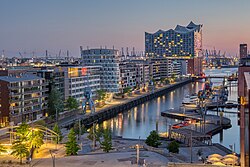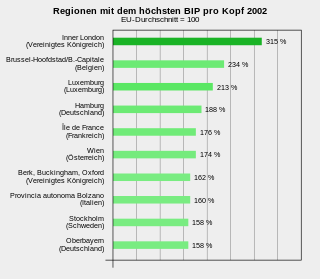Hamburg Metropolitan Region
Place in Germany From Wikipedia, the free encyclopedia
Place in Germany From Wikipedia, the free encyclopedia
The Hamburg Metropolitan Region (German: Metropolregion Hamburg) is a metropolitan region centred around the city of Hamburg in northern Germany, consisting of eight districts (Landkreise) in the federal state of Lower Saxony, six districts (Kreise) in the state of Schleswig-Holstein and two districts in the state of Mecklenburg-Vorpommern along with the city-state of Hamburg itself. It covers an area of roughly 26,000 square kilometres (10,000 sq mi) and is home to more than 5.1 million inhabitants.
Hamburg Metropolitan Region
| |
|---|---|
 Hamburg | |
| Anthem: Stadt Hamburg an der Elbe Auen [de] | |
 Location of the Hamburg metropolitan region in Germany | |
| Country | |
| States | |
| Largest Cities | Hamburg, Lübeck |
| Area | |
| • Metro | 26,000 km2 (10,000 sq mi) |
| Population | |
| • Metro | 5,100,000 |
| • Metro density | 192/km2 (500/sq mi) |
| GDP | |
| • Metro | €249.406 billion (2021) |
| Time zone | UTC+1 (CET) |
| Website | http://www.metropolregion.hamburg.de/ |
On 1 January 2006 the office of the Hamburg Metropolitan Region opened, as agreed in a state treaty of cooperation (Staatsvertrag über Zusammenarbeit) between Hamburg, Lower Saxony and Schleswig-Holstein.[3]
As of 2005, the Hamburg Metropolitan Region was made up of the city of Hamburg along with numerous rural districts in Lower Saxony and Schleswig-Holstein, altogether comprising 800 cities, towns and municipalities with an overall land area of 19,802 square kilometres (7,646 sq mi).[4] Since then it has expanded to cover the districts of Ludwigslust-Parchim (partially from 2012, entirely from 2017)[5] and Nordwestmecklenburg (from 2012)[6] in the state of Mecklenburg-Vorpommern.
|
States and districts
|
Largest cities and towns
| ||||||||||||||||||||||||||||||||||||||||||||||||||||||||||||||||||||||||||||||||||||||||||||||||||||||||||||||||||||||||||||||||||||||||||||||||||||||||||||||||||||||||||||||||||||||
* Districts and independent (German: kreisfrei) cities.
† Ludwigslust was merged into Ludwigslust-Parchim in 2011; pop. data for 2010


The Hamburg Larger Urban Zone (LUZ) as defined by Eurostat's Urban Audit covers an area of 7,303 km2 and in 2004 had a population of 3,134,620 inhabitants.[9] The Larger Urban Zone covers only the city of Hamburg and its directly neighbouring districts.[10] The Hamburg LUZ corresponds with the service area of the Hamburger Verkehrsverbund (HVV) transport association with an average population density of at least 150 inhabitants/km2.
| State | District* | Population (2012) |
Area |
Pop. density (2012) |
|---|---|---|---|---|
| – | 1,813,587 | 755 km2 | 2,400/km2 | |
| Harburg | 239,269 | 1,245 km2 | 190/km2 | |
| Stade | 195,606 | 1,266 km2 | 150/km2 | |
| Lauenburg | 187,905 | 1,263 km2 | 150/km2 | |
| Pinneberg | 298,826 | 664 km2 | 450/km2 | |
| Segeberg | 261,988 | 1,334 km2 | 200/km2 | |
| Stormarn | 232,911 | 766 km2 | 300/km2 | |
| Hamburg LUZ[11][12] | 2,903,198 | |||
| Lübeck | 211,713 | 214.13 km2 | 990/km2 | |
| Ostholstein | 197,882 | 1,391 km2 | 140/km2 | |
| Lübeck LUZ[11][12] | 391,373 | |||
| Bremerhaven† | 112,895 | 78,87 km2 | 1,400/km2 | |
| Cuxhaven | 198,115 | 2,073 km2 | 96/km2 | |
| Bremerhaven LUZ[11][12] | 288,635 | |||
* Districts and independent (German: kreisfrei) cities.
† not part of the Hamburg Metropolitan Region
Seamless Wikipedia browsing. On steroids.
Every time you click a link to Wikipedia, Wiktionary or Wikiquote in your browser's search results, it will show the modern Wikiwand interface.
Wikiwand extension is a five stars, simple, with minimum permission required to keep your browsing private, safe and transparent.